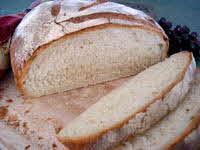HOW TO BAKE: FIVE FACTORS TO GET YOUR BREAD TO RISEThere are five important factors that make the difference between light, airy bread and a dense flop. None is difficult to manage—in fact, yeast is quite forgiving—but you’ll be a better bread baker if you understand these factors. Yeast is a living organism. As with any other living organism, it needs an acceptable environment in which to grow and multiply. As the yeast grows, it produces carbon dioxide gas that lifts the dough and creates an airy structure.
Five factors that affect how fast yeast will growFactor 1: TemperatureYeast is extremely sensitive to temperature. Ten degrees difference in the temperature of the dough profoundly affects the growth rate of yeast. 
The temperature where yeast grows best is around 78 degrees. The temperature of the dough is the result of the temperature of the water that you use, the flour temperature, and the temperature in your kitchen. Water that is 110 to 115 degrees mixed with cooler flour is intended to create a dough temperature close to this 78 degrees. In a bread machine, we use cooler water because of the warm, closed environment of the bread machine.
If you want to be a great bread baker, use a thermometer.
Factor 2: TimeThe longer the yeast is allowed to work, the more gas is created. In the right environment, yeast doubles and doubles again.
Bread is ready for the oven when it has doubled in volume, become soft, and is full of gas--not when the timer goes off. In a cooler kitchen, that might take a while.
With a bread machine, the bread begins to bake when the timer goes off whether it has risen or not. Since we can’t manipulate time when using a bread machine, we control yeast growth with other factors so that has risen optimally when the bread begins to bake.
Factor 3: Quantity of YeastThe quantity of yeast in the recipe makes a difference. Usually, a baker controls the rise with other factors and does not change the quantity of yeast. However, in a very cool environment you may want to increase the yeast slightly and in a very warm environment, reduce the yeast.
Factor 4: Quantity of WaterDough must be soft and flexible in order to rise properly--a factor of how much water is in the dough. If the dough is stiff, it is difficult for the expanding gases to lift the dough and create volume. After your dough is kneaded, it should be soft and nearly sticky. As a general rule when mixing bread, error on the side of too much water.
A softer dough will rise much more quickly than a stiff dough and so in your bread machine, a stiff dough will not rise properly before the baking begins. One of the easiest adjustments that you can make to a bread machine recipe or mix that doesn’t perform quite right is adjust the water by a tablespoon.
Factor 5: SaltSalt kills yeast and a too salty dough will impede yeast growth. One-half teaspoon of salt in a recipe makes quite a difference. Always measure salt carefully. If you want to speed up the rise, reduce the salt by 1/2 teaspoon. Add a similar amount to slow the rise.
Rising speedWhy do we care how fast the bread rises? In a bread machine, it is critical. On the counter, within reasonable bounds, it probably doesn’t make a difference. In fact, the flavors trapped in bread dough improve with age. A long, slow age creates terrific bread. Still, you are a more competent baker if you understand what is going on inside that ball of dough. Courtesy of the Prepared Pantry - www.preparedpantry.com | 